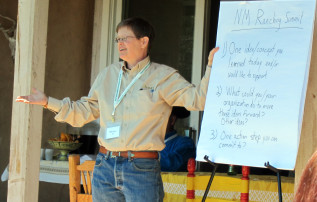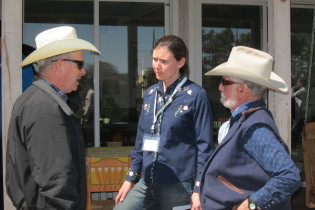A beautiful spring day was the setting for the New Mexico Policy Maker Day hosted by HMI and the Ranney Ranch near Corona, New Mexico and supported by the Thornburg Foundation.

Representatives from federal and state agencies, along with local NGOs met with ranchers to discuss innovative strategies that increase water availability to the land, increase biodiversity and improve ranch profitability as well as possible incentive programs to encourage good land management practices. A two-page summary of those strategies and proposed programs is available here. For a more in depth look at those strategies and the research that supports those strategies, read this 28-page white paper here.
We started the morning with introductions and an orientation to the Ranney Ranch. Ranch owner, Nancy Ranney, and Ranch Manager, Melvin Johnson outlined some of the challenges the ranch has faced over the years – as well as solutions they have implemented. We then toured the ranch to see and learn first-hand how the land, the livestock, and the ranch have profited from planned grazing and improved financial management, as well as various land improvement projects they have implemented. Key management practices that have helped are:
Clearing invasive juniper & cholla for increased water infiltration and grass production
Proper road construction and runoff management together to retain and spread rainfall on the land not channeled down roads and arroyos
Improved fencing and water development to improve pasture utilization and plant recovery times
Increased plant productivity and diversity through increased, short-term animal impact.
Direct marketing weaned calves as grassfed beef to maximize profit/calf

These practices have allowed the ranch to cut cost of supplemental feed by more than $25,000/year while increasing average calf weights by 100 lbs. Further, Nancy and Melvin estimate that the planned grazing program and road construction has increased their soil moisture by more than 1.5 million gallons/acre. While we feasted on grassfed burgers from the Ranney Ranch, Laurie Bower from the Southwest Grassfed Livestock Alliance talked about the challenges and opportunities in developing the grassfed livestock market here in New Mexico. Ranching during times of drought was a hot topic for the day and Holistic Management practitioners Tom Sidwell and Sid Goodloe shared their experiences in mitigating the effects of drought on their ranches near Tucumcari and Capitan, New Mexico. We closed out the day with a brainstorming session facilitated by Holistic Management Certified Educator & HMI Interim CEO, Ann Adams. Some of the discussion points brought up included:

There are opportunities to establish incentives for good management; land managers must see benefits to new approaches, financial incentives are important; also important to see the "societal benefits" of what happening at a place like this, how work impacts the entire ecosystem
There is an economic development story here; tell it. Producers are producing products we want, offering answers to resource issues we are worried about (water, drought). There is a window here to communicate this message
If you can add value to something, that is a story
Planned grazing is at intersection of ranchers and environmentalists; it's a "win-win".
Many ranchers are not aware of programs that currently exist and how to apply/take advantage of them. SWCD are a good avenue of outreach for them. However, asking more of the USDA employees to come talk about their programs and events is also important.
Extension Educators can also be utilized in programming to share best practices.
A lack of USDA inspectors and processors is a challenge for ranchers pursuing the grassfed/local market.

More education on planned grazing and sustainable profitable techniques would be beneficial
More and more young people are interested in production agriculture, and that’s a great time to start educating them
We need to be cautious of too much regulation and “one size fits all” approaches
Many ranchers are reluctant to try new approaches due to perceived risk. Programs or policies to help mitigate risks and reduce barriers could be beneficial
NM has strong representation on the appropriations and agricultural committees, so opportunities to fund pilot programs may exist.
Land/management transition from older to younger farmers is a time of opportunity (as is the crisis surrounding drought). It has resulted in more people collaborating and talking (particularly environmentalists and ranchers)
We need to work with agricultural producers to teach them both the business and the production side of agriculture.
Use Congressional offices to search for grant funding.
The BLM has a Restore New Mexico program where they have funded $2 million/year in projects. Look at possible collaborations there.
Possible tax credits could come from insurance premium fund as a result of the Affordable Care Act.
NM Cattlegrower’s Conference can provide outreach for effective programs. Likewise, they are always looking for good stories of good producers for their publication.
We need more agricultural producers telling their story at the legislature
State Land Office lease fees are focused on income generation and stewardship.
We need to help producers and consumers see the benefits of good land management.
Participants noted that this was an educational and productive program and a great start to working collaboratively in the future on ways to improve the ranching industry in New Mexico.
Thanks to the following organizations for participating in this program:
Body Café of Santa Fe
Bureau of Land Management
Carrizo Valley Ranch
JX Ranch
NM State Department of Agriculture
NM State Land Office
NM State Senator Peter Wirth
NM State Senator John Ryan
NM Cattlegrower’s Association
Quivira Coalition
Ranney Ranch
Senator Heinrich’s Office
Senator Udall’s Office
Southwest Grassfed Livestock Alliance
Think New Mexico
Thornburg Foundation
USDA Rural Development

